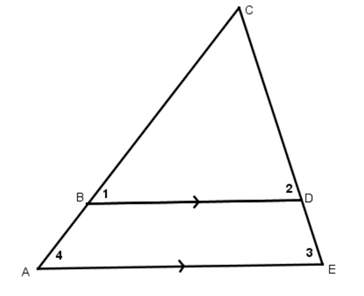
Concept explainers
To compare: The
Explanation of Solution
Given information:
The triangle proportionality theorem and the triangle midsegment theorem.
The triangle proportionality theorem is, “If a line is parallel to one side of a triangle and intersects the other two sides, then it divides the sides into segments of proportional length”.
From the above statement, ¯BD||¯AE .
Consider the following figure,

From AA similarity postulate, ΔACE∼ΔBCD and,
CACB=CECDCB+BACB=CD+DECD1+BACB=1+DECDBACB=DECD
Hence, if a line is parallel to one side of a triangle and intersects the other two sides, then it divides the sides into segments of proportional length.
The triangle midsegment theorem is, “A mid-segment of a triangle is parallel to one side of the triangle and its length is one half the length of that side”.
Consider the following figure,

From the above statement, ¯DE is a mid-segment of ΔABC . From mid-point theorem,
AD=DBAE=EC
From the figure,
AB=AD+DBAB=AD+ADAB=2ADABAD=2
And,
AC=AE+ECAC=AE+AEAC=2AEACAE=2
So, ABAD=ACAE .
From SAS similarity, ΔADE∼ΔABC and ∠ADE=∠ABC , so ¯DE||¯BC .
From ΔADE∼ΔABC
BCDE=ABADBCDE=2DE=12BC
Hence, a mid-segment of a triangle is parallel to one side of the triangle and its length is one half the length of that side.
Chapter 7 Solutions
Geometry, Student Edition
Additional Math Textbook Solutions
A Problem Solving Approach To Mathematics For Elementary School Teachers (13th Edition)
Algebra and Trigonometry (6th Edition)
University Calculus: Early Transcendentals (4th Edition)
Introductory Statistics
A First Course in Probability (10th Edition)